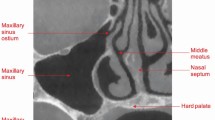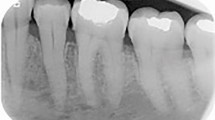Key Points
-
Warns the reader that late presentation of maxillary sinus tumours is common due to the nonspecific nature of presenting symptoms.
-
Stresses how performing a simple cranial nerve examination or diagnostic imaging can be key to a definitive diagnosis.
-
Underlines how prompt communication between specialities and care providers is essential when presenting symptoms of facial pain are of an atypical nature.
Abstract
Objective Malignant tumours of the nasal cavity and paranasal sinuses are rare and late presentation of a maxillary sinus tumour is common due to the vague nature of the symptoms which can delay diagnosis.
Methods We report a female with a maxillary sinus tumour who was initially diagnosed with chronic idiopathic facial pain (CIFP) and sinusitis, which subsequently led to a delay in diagnosis and treatment of her tumour.
Results There was no clinical extra- or intra-oral pathology, however, she had varying clinical presentations of facial pain, anosmia, loss of gustatory function, and infra-orbital nerve paraesthesia. CT and MRI scans confirmed obliteration of the left maxillary sinus by a solid mass involving ethmoid and sphenoid sinuses and some cranial nerves. Biopsy confirmed a poorly differentiated carcinoma of the ethmoid and sphenoid sinuses and invasion of the cavernous sinus.
Conclusion A morbid, but hidden tumour was left undiagnosed due to the unusual presentation of the patient's symptoms. It is essential that all patients are managed holistically and thorough historical, clinical and radiographic examination and appropriate investigations are carried out to prevent unnecessary and potentially time-wasting treatment.
This is a preview of subscription content, access via your institution
Access options
Subscribe to this journal
Receive 24 print issues and online access
$259.00 per year
only $10.79 per issue
Buy this article
- Purchase on Springer Link
- Instant access to full article PDF
Prices may be subject to local taxes which are calculated during checkout



Similar content being viewed by others
References
Jham B C, Mesquita R A, Aguiar M C F, Vieira do Carmo M A. A case of maxillary sinus carcinoma. Oral Oncol Extra 2006; 42: 157–159.
Bhattacharyya N. Factors affecting survival in maxillary sinus cancer. J Oral Maxillofac Surg 2003; 61: 1016–1021.
Scully C, Felix D H. Oral medicine – update for the dental practitioner, orofacial pain. Br Dent J 2006; 200: 75–83.
Madland G, Feinmann C. Chronic facial pain: a multidisciplinary problem. J Neurol Neurosurg Psychiatry 2001; 71: 716–719.
Aggarwal V R, McBeth J, Zakrzewska J M, Macfarlane G J. Unexplained orofacial pain – is an early diagnosis possible? Br Dent J 2008; 205: E6.
Bell G W, Joshi B B, Macleod R I. Maxillary sinus disease: diagnosis and treatment. Br Dent J 2011; 210: 113–118.
Epstein J B, Waisglass M, Bhimji S, Le N, Stevenson-Moore P. A comparison of computed tomography and panoramic radiography in assessing malignancy of the maxillary antrum. Eur J Cancer B Oral Oncol 1996; 32B: 191–201.
Scully C, Felix D H. Oral Medicine — update for the dental practitioner, disorders of orofacial sensation and movement. Br Dent J 2005; 199: 703–709.
Allerton R. Acute mesenteric ischaemia associated with 5-FU, cisplatin and vincristine chemotherapy. Clinical Oncol (R Coll Radiol) 1996; 8: 116–117.
Okamoto T, Noguchi Y, Yoshikawa T et al. Chemotherapy-induced thrombotic occlusion of mesenteric arteries – case report and review of the literature. Gan To Kagaku Ryoho 1994; 21: 1279–1282.
Acknowledgements
This report is written in memory of Lyn Tompson-Dewey, whose strength and positivity were inspirational. We thank her family for allowing us to share this important story, so other patients may benefit from it in the future.
Author information
Authors and Affiliations
Corresponding author
Additional information
Refereed paper
Rights and permissions
About this article
Cite this article
Parmar, S., Chapple, I. Late diagnosis of an occult tumour – what lessons can we learn?. Br Dent J 212, 531–534 (2012). https://doi.org/10.1038/sj.bdj.2012.468
Accepted:
Published:
Issue Date:
DOI: https://doi.org/10.1038/sj.bdj.2012.468
This article is cited by
-
Oral surgery II: Part 2. The maxillary sinus (antrum) and oral surgery
British Dental Journal (2017)



